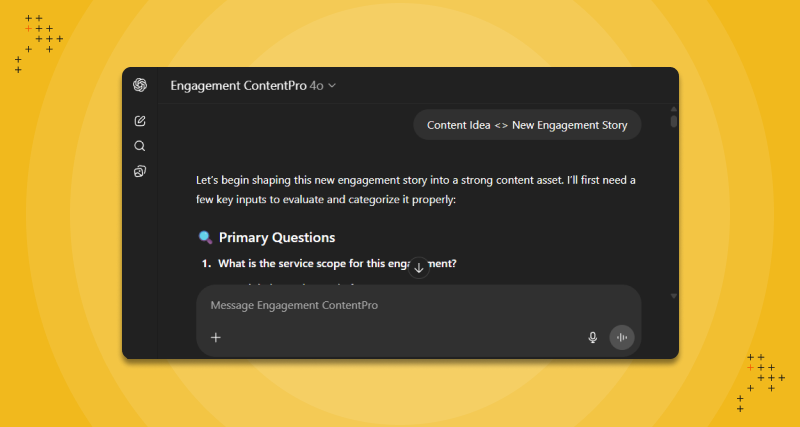Introduction
Content isn’t just storytelling; it’s impact amplification. Campaigns, cause awareness, donor engagement, and volunteer mobilization all demand a consistent, high-quality content pipeline. But various organizations face acute resource constraints. Marketing teams wear multiple hats, and outsourcing often stretches budgets thin.
In this environment, generative AI offers promise, but also pitfalls. How do you harness its speed without sacrificing authenticity, strategic alignment, or factual integrity? At Axelerant, we faced these questions head-on while building a custom GPT model for one of our non-profit clients. What emerged wasn’t just a technical deployment; it was a scalable strategic framework.
Why Off-The-Shelf GPT Fails Organizations
Generic GPT models are trained on mass internet data. Their tone is neutral, their structure is broad, and their assumptions often reflect corporate marketing norms. That approach breaks down quickly in the real world, where:
- Tone must balance inspiration with credibility
- Messaging must align with values, not sales funnels
- Content must respect lived experiences and ethical storytelling
What one of our non-profit clients needed wasn’t another content tool. They needed an assistant who understood how purpose-driven narratives work, and why their campaigns need nuance. The solution? Customization, not of code, but of context.
Building A Custom GPT With Strategic Training Loops
Step 1: Deep-Dive Into Mission And Messaging
We started by immersing ourselves in one of our non-profit clients’s identity, what they stood for, who they served, and how they communicated their impact. This wasn’t surface-level branding. It involved:
- Analyzing their service areas to understand core offerings like branding, web development, marketing, and support.
- Reviewing campaign narratives across different cause verticals to identify recurring messaging patterns and emotional anchors.
- Studying high-performing blog posts to dissect tone, structure, and engagement triggers.
- Consulting internal stakeholders to clarify strategic goals, communication preferences, and content do’s and don’ts across service lines. This foundational work ensured that our GPT wasn’t generating content in a vacuum; it was building from purpose-rich context.
Step 2: Structured Content Brief Enforcement
To prevent generic or misaligned content, the GPT was trained to rely exclusively on structured content briefs. These briefs were more than checklists, they were strategic roadmaps that included:
- The blog topic and its strategic relevance to ongoing campaigns or donor initiatives.
- The audience profile with details such as familiarity with the cause, preferred content format, and decision-making power.
- The brand’s unique positioning and what differentiated the messaging from peer organizations.
- Specific content expectations including tone (e.g., hopeful vs. assertive), required assets (e.g., downloads, checklists), and strict word count ranges. If any of these were missing or incomplete, the GPT was instructed to pause and prompt the user for clarification. This enforced discipline elevated output quality and minimized editorial rework.
Step 3: Human-In-The-Loop Verification
Even the best AI benefits from human review. At Axelerant, every GPT-generated draft was subjected to a dual-layered review process:
- Strategists reviewed each sentence for alignment with brand narratives, ensuring that the tone struck the right balance of authenticity, urgency, and empathy.
- Content leads examined factual integrity, narrative progression, and audience resonance, flagging anything that felt mechanical or off-brand. This human layer acted as a final polish, and more importantly, as a continuous training dataset. Approved versions were systematically fed back to the GPT to recalibrate its understanding of quality.
Step 4: Hallucination Mitigation
One of the biggest risks in AI-generated content is the insertion of false data, what we call hallucinations. To tackle this, our system was trained with strict rules:
- GPT outputs were required to include citations or supporting URLs for all data points, statistics, and examples. These had to be from specific or credible third-party sources.
- If no source could be identified, the model was instructed to either omit the data or transparently flag it as unverifiable.
- Prompts included strict instructions to avoid speculation. For example, the model couldn’t assume campaign performance results or donor metrics unless documented. This helped establish trust in the content while protecting the brand’s credibility and ethical standards.

Gaining A Strategic Lift
This framework didn’t just increase velocity, it increased content quality and strategic cohesion. Here’s how:
- 50% Reduction In Drafting Time: Time to first draft was cut in half, enabling faster campaign rollouts.
- 2X Content Volume: The same team produced twice the content, with more time for stakeholder interviews and strategic reviews.
- Consistency At Scale: Messaging aligned across blogs, campaign pages, and microcopy, because the model had learned what alignment looked like.
- Creative Focus Restored: Human creators could shift focus from formatting and prompt wrangling to concepting, research, and insight development.
Implications For Marketing Leaders
The takeaway here isn’t “use GPT.” It’s use GPT strategically. The power lies not in the AI itself, but in how it’s trained, governed, and integrated.
If you’re leading an agency team, ask:
- Have we defined what quality content means for us?
- Do our writers and tools share that definition?
- Are we treating AI like a content vending machine or a junior team member who needs onboarding?
Building Your Own Strategic GPT Framework
.webp?width=1385&height=386&name=Body%20Image%202%20(1).webp)
Building a GPT workflow that mirrors your mission, voice, and marketing intent isn’t a plug-and-play operation. It requires cross-functional alignment and a methodical rollout. Here’s how agency partners can approach it:
1. Codify Brand Voice With Surgical Precision
Create a living document that outlines:
- Key themes and preferred vocabulary
- Examples of tone (what’s “on-brand” and what’s not)
- Guidelines for narrative structure (e.g., empathy before data, action before ask)
- Phrases to avoid due to sensitivity, tone-deafness, or ethical storytelling
This becomes your AI’s ethical compass.
2. Institutionalize Strategic Content Briefs
Treat every piece of content like a campaign. Include:
- Target audience personas
- Objectives and KPIs (awareness, engagement, conversion)
- Mandatory messaging or CTAs
- Required length, SEO terms, and asset types (e.g., infographic, checklist)
Feed this brief as a prerequisite into your GPT prompts. Train the AI to ask for missing components before proceeding.
3. Build Multi-Layered Feedback Loops
Make AI an iterative partner, not a one-shot tool:
- Maintain a repository of approved content as reinforcement material
- Create prompt feedback templates (e.g., what worked/didn’t in the output)
- Involve both content strategists and project managers in evaluating first drafts
The more structured your feedback, the faster the AI learns.
4. Create A Governance Checklist To Audit Outputs
Every draft should be reviewed against a fixed rubric:
- Accuracy of data and presence of credible citations
- Consistency with brand tone and emotional resonance
- Avoidance of unverified claims or speculative metrics
- Structural adherence to the original brief
Use this checklist to train both the AI and the team to validate its work.
5. Go Beyond Efficiency To Measure Strategic Impact
Track how GPT-powered content affects:
- Campaign launch velocity
- Quality scores (from stakeholders or audiences)
- Internal satisfaction among content teams
- SEO, traffic, and user engagement
Build dashboards that reflect not just quantity, but alignment, resonance, and strategic lift.
AI Is Not A Shortcut. It’s A Strategic Lever.
At its worst, AI adds noise. At its best, it amplifies the right signal.
By embedding AI into a structured strategy, one of our non-profit clients turned content production from a bottleneck into a business advantage. And in the process, they redefined how organizations can scale without dilution.
Interested in building a custom GPT workflow for your mission-driven brand? Let’s talk.
%20copy.png)
Sayan Mallick, Marketing Coordinator
A former professional e-sports player, passionate about anime and technology—that’s Sayan. He is an eccentric explorer who likes to read, play games, teach, and spend time with his pet dog, Buddy.

 We respect your privacy. Your information is safe.
We respect your privacy. Your information is safe.



Leave us a comment